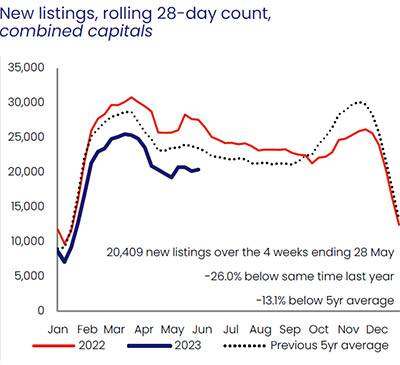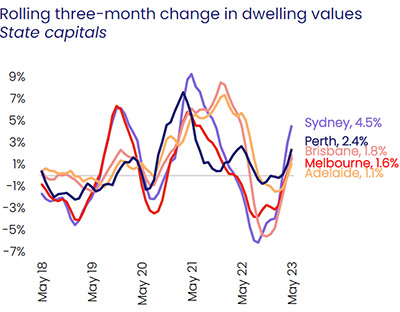Sydney, Brisbane, Melbourne real estate reclaiming post-pandemic price falls
Australia's three biggest cities are making progress towards regaining the lost ground their property markets conceded in the wake of the pandemic.
Since bottoming out in February, property prices across Australia’s capital cities and regions alike have embarked on a three-month price recovery.
While still off their Covid-era peaks, Sydney, Melbourne and Brisbane have made substantial inroads towards a full recovery.
Perth is the only capital city where dwelling values have returned to record highs, while Adelaide is the other state capital in positive territory in terms of dwelling prices over the past 12 months.
While home values are still 9.6 per cent below the January 2022 peak, it is Sydney that is leading the pace of price recovery.

Source: CoreLogic.
CoreLogic’s national Home Value Index (HVI) released Thursday (1 June) showed the pace of growth throughout May had accelerated sharply to 1.2 per cent.
If that pace of capital growth was sustained, all capitals outside Hobart would have likely returned close to or above their price peaks from early to mid-2022.
As migration gathers pace and renters take whatever steps possible to get out of the relentless rent hike cycle, supply has failed to meet demand.
CoreLogic Research Director, Tim Lawless, noted the positive property price trend is a symptom of persistently low levels of available housing supply running up against rising housing demand.
Advertised listings trended lower through May with roughly 1,800 fewer capital city homes advertised for sale relative to the end of April.
“Inventory levels are 15.3 per cent lower than they were at the same time last year and 24.4 per cent below the previous five-year average for this time of year,” he said.

Source: CoreLogic
“With such a short supply of available housing stock, buyers are becoming more competitive and there’s an element of FOMO creeping into the market.
“Amid increased competition, auction clearance rates have trended higher, holding at 70 per cent or above over the past three weeks, while for private treaty sales, homes are selling faster and with less vendor discounting.”
Speaking at the Property Council’s recent Future Cities Summit, Kate Meyrick, Director of urban planners Urbis, said the housing shortage looked likely to get worse.
“Not just because we’ve got a growing population, not just because we are slightly slowing in our delivery of housing units, not just because we’ve got more household formations but also because we are expecting to see another 400,000 skilled migrants enter the country this year.”
While the lack of available housing stock was driving up home prices, as well as rents, there was a potential dampener waiting in the wings.
Will the mortgage cliff be the big fall?
Home prices could take a hit if an influx of borrowers facing the so-called mortgage cliff decide to offload suddenly unaffordable properties at the same time.
There are around 880,000 households expected to come off ultra-low fixed rate home loans into variable rate loans in coming months.
Anna Porter, Principal of Suburbanite, said property owners unable to weather that sort of storm should consider selling sooner rather than later.
“There are the households who fixed a loan in 2021 when the RBA cash rate was still at a record low of 0.1 per cent, which typically saw those on a half a million dollar mortgage pay around $2,100 monthly in repayments on a 1.92 per cent fixed rate.
“Repayments on this type of mortgage are expected to increase by around $1,500 per month once fixed rates expire and quite simply, a lot of households will unfortunately struggle to continue affording their home.
“We can expect to see a lot more properties come to market, increased listings and downward pressure on values as a result.”

Source: CoreLogic
Ms Porter advises now is the time to sell, not in six to 12 months as currently sellers are positioned to get the best price as opposed to waiting.
Mr Lawless played down the expected impact of the looming switch to higher variable rates.
“It would be naïve to think mortgage arrears won’t rise through the second half of the year, however, a material lift in motivated (distressed) sellers seems unlikely.
“Helping to offset these risks are tight labour market conditions and a healthy level of household savings accrued.”
He added that the outlook for property prices would continue to rest on the Reserve Bank of Australia and interest rates.
“Economists are divided on the cash rate outlook, highlighting the sheer uncertainty about whether we have moved through a peak in the cash rate or not.
“Even if the rate hiking cycle is over, the timing of a rate cut also remains highly uncertain but once interest rates start to reduce, we could see more sustained momentum gather in housing markets.”
Regional real estate making progress
Regional property markets bore the brunt of a return to the cities by those who had fled to country towns to escape the pandemic but most markets were now on an upward trajectory.
The combined regionals index rose half a percent in May, following a 0.2 per cent and 0.1 per cent rise in March and April.
“Although regional home values are trending higher, the rate of gain hasn’t kept pace with the capitals,” Mr Lawless said.
“Over the past three months, growth in the combined capitals index was more than triple the pace of growth seen across the combined regionals at 2.8 per cent and 0.8 per cent respectively.”
Although advertised housing supply remains tight across regional Australia, demand from net overseas migration is less substantial.
ABS data points to around 15 per cent of Australia’s net overseas migration being centred in the regions each year. Additionally, a slowdown in internal migration rates across the regions has helped to ease the demand side pressures on housing.
While capital city home sales are well below the recent highs recorded in late 2021, they are roughly in line with the previous five-year average, with transactions outstripping new listings in the past three months, Mr Lawless said.





















